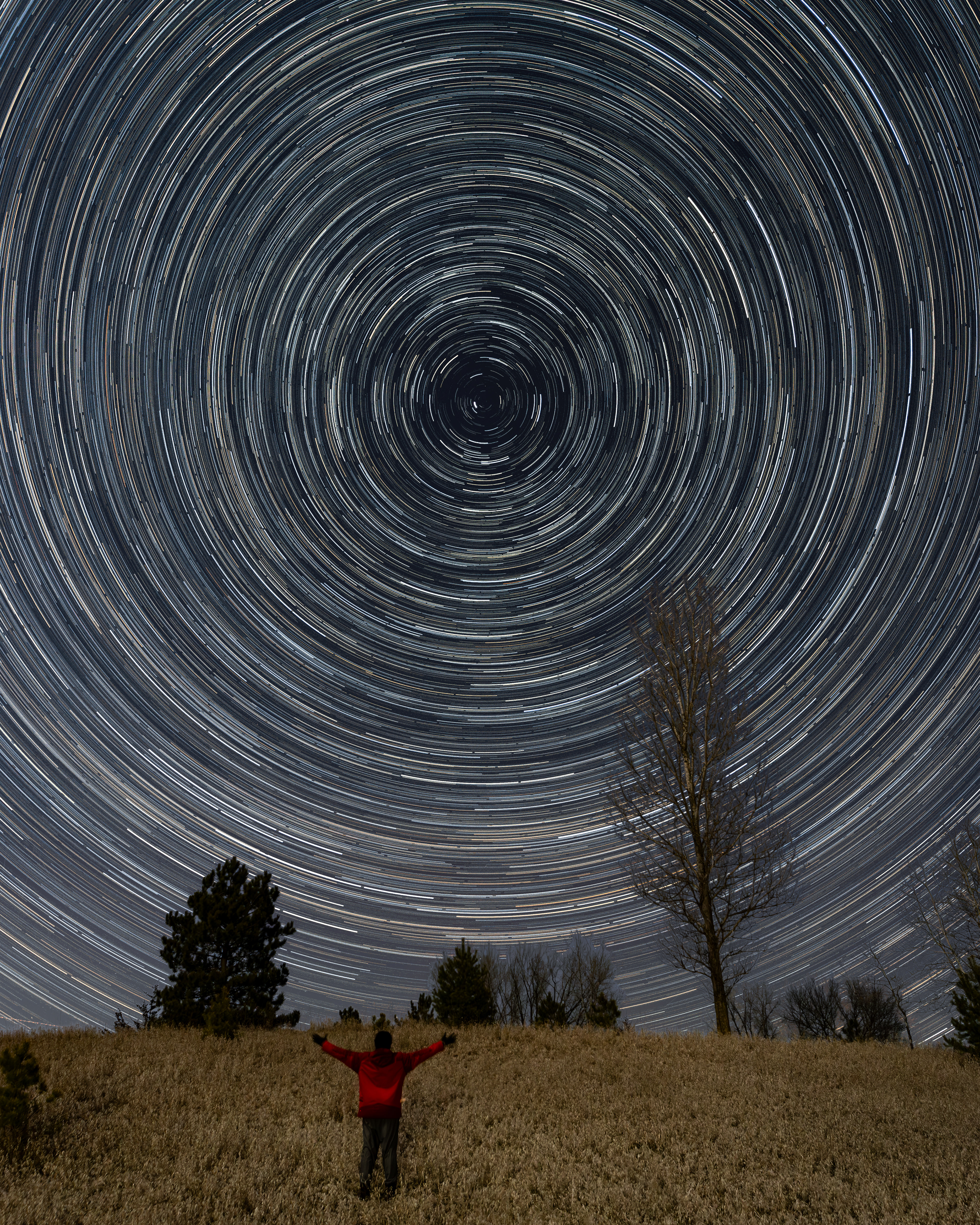“Look Up” – They Said. So, I Did.
I’ve always had a thing for the night sky — maybe it’s the mystery, or maybe it’s just the quiet that comes with it. Last week, I packed my gear, some water, and zero expectations and headed out into southeastern Minnesota to capture the stars in motion. Turns out, the sky had big plans for me.
Composition 1: Infinity Spin - time tangled in light.
First stop for the night was Pine Point Regional Park in Stillwater, MN. This is the first photo from the last night’s shoot. And this is my first star trails photo of this year. I’ve always loved making star trails compositions, and this year I wanted to be a bit more deliberate about having a subject in the foreground instead of just the sky and the stars. This composition is the start of such effort and practice.

Pine Point Regional Park, Stillwater, MN

Pine Point Regional Park, Stillwater, MN
Photo Information:
Date: April 5, 2025
Location: Southeastern Minnesota
Camera: Canon 90D
Lens: Rokinon 14mm f/2.8 EF-fit
Exposure - Foreground: f/4, ISO 800, 20sec
Exposure - Sky: f/4, ISO 400, 30sec (195 images stacked)
Date: April 5, 2025
Location: Southeastern Minnesota
Camera: Canon 90D
Lens: Rokinon 14mm f/2.8 EF-fit
Exposure - Foreground: f/4, ISO 800, 20sec
Exposure - Sky: f/4, ISO 400, 30sec (195 images stacked)
There are usually a few ways of exposures to create a start trails photo:
(a) Multiple Short Exposures:
This approach involves taking several shorter exposures, each under the time limit dictated by the 500-rule, to ensure sharp stars in each image. For instance, using a 14mm lens (14 x 1.6 = 22.4mm), the maximum exposure time is approximately 22 seconds (500 / 22.4). Set up an intervalometer with a 3–5 second interval between shots, then stack them together. This method offers control over each image, allowing you to discard any problematic frames without significantly affecting the final result. It's also beneficial if you plan to create a time-lapse of the stars' movement.
(a) Multiple Short Exposures:
This approach involves taking several shorter exposures, each under the time limit dictated by the 500-rule, to ensure sharp stars in each image. For instance, using a 14mm lens (14 x 1.6 = 22.4mm), the maximum exposure time is approximately 22 seconds (500 / 22.4). Set up an intervalometer with a 3–5 second interval between shots, then stack them together. This method offers control over each image, allowing you to discard any problematic frames without significantly affecting the final result. It's also beneficial if you plan to create a time-lapse of the stars' movement.
(b) Single Very Long Exposure:
Alternatively, you can opt for a single, extended exposure lasting an hour or more. While this allows for a lower ISO setting, it carries the risk that any disturbance during the shoot—such as camera shake or environmental factors—can compromise the entire image. Additionally, this method doesn't facilitate the creation of a time-lapse.
Alternatively, you can opt for a single, extended exposure lasting an hour or more. While this allows for a lower ISO setting, it carries the risk that any disturbance during the shoot—such as camera shake or environmental factors—can compromise the entire image. Additionally, this method doesn't facilitate the creation of a time-lapse.
The post-processing phase begins with initial edits in Lightroom. Subsequently, all the photos are stacked to produce the star trails image, using either the free application StarStaX or Photoshop's lighten blend mode. StarStaX offers various options for creating star trails, including the ability to save cumulative trails from the first to the last photo, which can then be compiled into a time-lapse. The time-lapse for this composition is showcased below, created from the cumulative images generated by StarStaX in 'comet' mode.
Timelapse Information:
Date: April 5, 2025
Location: Southeastern Minnesota
Camera: Canon 90D
Lens: Rokinon 14mm f/2.8 EF-fit
Exposure - Foreground: f/4, ISO 800, 20sec
Exposure - Sky: f/4, ISO 400, 30sec (195 images stacked)
Software for timelapse: Photoshop (utilizing the exported comet-mode cumulative star trails images from StarStaX)
Date: April 5, 2025
Location: Southeastern Minnesota
Camera: Canon 90D
Lens: Rokinon 14mm f/2.8 EF-fit
Exposure - Foreground: f/4, ISO 800, 20sec
Exposure - Sky: f/4, ISO 400, 30sec (195 images stacked)
Software for timelapse: Photoshop (utilizing the exported comet-mode cumulative star trails images from StarStaX)
There’s something about photographing star trails that always reminds me of how tiny we are — and how big everything else is. Time becomes visible, and motion becomes poetic. It still feels like a privilege to have these kinds of places with less light pollution, within just 30min from home.7
***Blog post in progress***